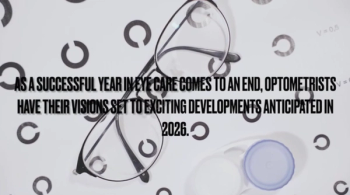
AAOpt 2024: Preserving vision by detecting and treating GA
Steve Ferrucci, OD, FAAO, discussed the detection and treatment of geographic atrophy during his AAOpt 2024 lecture, "Imaging Techniques and Emerging Therapies for Geographic Atrophy."
Steve Ferrucci, OD, FAAO, discussed the detection and treatment of geographic atrophy (GA) during his AAOpt 2024 lecture, "Imaging Techniques and Emerging Therapies for Geographic Atrophy," given alongside Carolyn Majcher, OD, FAAO. Ferrucci emphasized the importance of early detection through multimodal imaging, including color, fundus photos, fundus autofluorescence, and optical coherence tomography (OCT). New FDA approved medications, such as Syfovre and Izervay, can slow GA progression by 25-35%, preserving usable vision. Ferrucci highlighted that patients with extrafoveal lesions or hyperfluorescence around lesions should be referred promptly. He stressed the urgency of recognizing GA now that treatments are available, as vision loss can occur rapidly once lesions start growing.
Video transcript:
Editor's note: The below transcript has been lightly edited for clarity.
Steven Ferrucci, OD, FAAO:
My name is Dr Steve Ferrucci. I'm chief of optometry at the Sepulveda VA, which is out in Los Angeles. And I did a lecture on geographic atrophy, focusing both on how to detect it through imaging, as well as some of the new treatments out there. And now that we have treatments that slow down the progression of geographic atrophy, which is great, the first step now is recognizing GA and then referring those patients that could potentially benefit from treatment out. So if you can't detect it, you really can't do anything. So that's what we focused on; talked about multi modal imaging, how you can use many different things: color fundus photos, fundus, autofluorescence, as well as OCT, and the advantages and disadvantages to each different modality. Essentially, I always tell people, whatever modality you have, or as many as you have, use whatever you have, use as many tools as you have in your toolbox to look for geographic atrophy. And then we discussed the 2 newer FDA approved medications, syfovre and izervay, and how they slow down the progression of geographic atrophy lesions, thereby allowing our patients to have longer time with usable visions. We talked about that as well, and then we closed by talking about which type of patients would be probably the best for referrals: those patients have extrafoveal lesions, and if you can see clear progression and you see those lesions getting closer to the macula. That's a patient you would think about sending out, also with fundus autofluorescence, if you see some hyper fluorescence of lesions, perhaps often circular around the lesion, that's also a lesion that we think is active and might benefit from treatment as well.
So really, as optometry, we are the ones that have these patients with geographic atrophy in our offices because there has not been any treatment. So they usually don't find themselves a retinal specialist office because there's no treatment for it. So these are patients we should have in our offices. And again through the use of these medications, they show they can slow down the lesion size growth by it–depends a little bit–25 to 35% or so. So the idea is, if we can slow down the lesion growth, prevent it from hitting the macula, prevent it from causing vision loss in these patients, then we've really helped these patients live longer lives with good, usable vision so they can drive and things like that, which obviously are important to our older patients' independence.
The OCT is probably one of the better ways to look for it. So look at the OCT, both the en face images as well as a cross section. On the cross section, we're looking for what we call hyper transmission defects, where you actually see the light penetrating more in the area of geographic atrophy. So that's what we want to look for on OCT.
My key point would be that geographic atrophy is it's more common than we probably think. And now that we have drugs to slow down the progression, it's time to start really paying attention to geographic atrophy. I would argue that when we didn't have any treatments, you know, it really wasn't that important if we missed it, because we couldn't do anything about anyway. But now that we have some treatments, it's important to be looking for it in our patients. And the other takeaway is that vision loss from geographic atrophy, these lesions grow quicker than many of us thought, I think. So it's important to refer these patients out, not immediately, but promptly. Because these lesions, once they start to grow, they do progress more rapidly, I think, than some of us previously thought.
Newsletter
Want more insights like this? Subscribe to Optometry Times and get clinical pearls and practice tips delivered straight to your inbox.













































.png)


